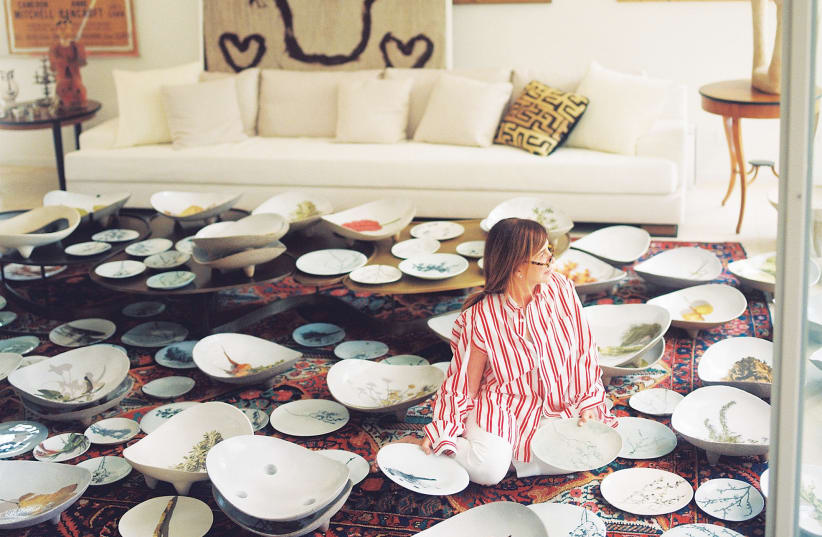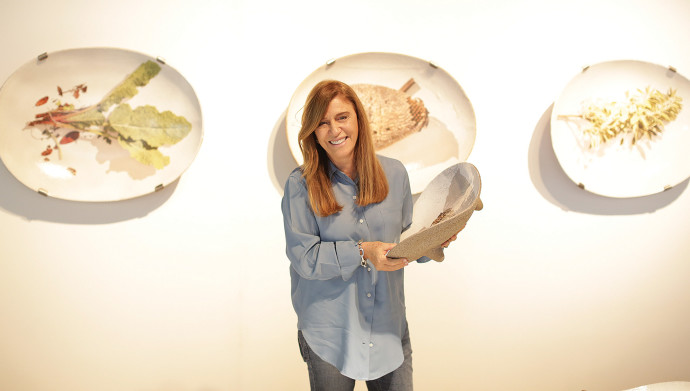‘My great uncle, Arthur Ruppin believed that our future depends on working the land,” says designer and artist Orna Tamir-Schestowitz, about Seeds of Heritage, her recent project. She had just returned from Japan, where she presented the project at the DESIGNART Tokyo 2022 festival.
“The values that I grew up with were Zionism and the love of our land. The project echoes those days of innocence, a longing for the flavors and simplicity of yesterdays, before man destroyed the land and the seeds. And longing, as we all know, produces art."
An acclaimed Israeli designer, artist, curator and author, Tamir-Schestowitz published an architecture and design book in 2000 titled Homes with Personal Style. In 2005, she curated the Offering Reconciliation exhibition at the Ramat Gan Museum, bringing together Israeli and Palestinian artists.
This exhibition later traveled to the UN headquarters in New York. Ceramic works were first exhibited at the Eretz Israel Museum in Tel Aviv, as part of the 2018 show The Goodness of the Land and its Heritage.
Seeds of Heritage is an ongoing project. Tamir-Schestowitz designed organically shaped ceramic vessels, and then superimposed on them photographic images of the bounty of the Israeli earth. The artist-curated a studied series of portraits of herbs, fruits and vegetables, rooted in the same earth from which she mined the clay used for her pottery.
The carefully selected and photographed plants were cultivated from heirloom seeds that naturally evolved in the region over generations. Each vessel presents a sample of burgeoning produce originating from the Galilean orchard of Erez Komarovsky, a tribute to the natural cycle of life and the rich agricultural legacy of the Galilee.
“Heritage seeds are pure, free of hormones and pesticides, they are clean and simple. Unfortunately, global warming, floods, wars and droughts – all pose a great danger to the world’s agriculture. The war in Syria, for instance, forced the country to move its local seed bank to Norway for protection. I wanted to raise awareness to that too, to bring back the right and just treatment of the land and agriculture.”
How do you go about creating the large-scale vessels – are they all hand-made by you?
“No two vessels are alike. Each one is different in shape and has free edges. The first bowl I created was large, womb-like, with three legs and made from grog granulated clay that grants it a rough, organic finish. It seemed like a solid basis for containing the idea of heritage seeds, which was sprouting in my thoughts at the time. I knew I wanted the bowls to hold all the goodness of the land.
This led me to start researching local heritage seeds. I visited farms and the Volcani Center, and in the end, together with Dan Peretz, we photographed fruit and vegetables that grow in my dear friend chef Erez Komarovsky’s organic orchard.
Peretz and I constructed an outdoor studio on the farm, and we photographed the produce minutes after it was picked. It was important to me to preserve artistic values, such as natural light, the seasons, authenticity and organic cultivation.”
The next stage was to impose the images inside the oval vessels. “Not going into too many technical details, I can only mention that I place great importance on how the image is applied onto the vessel, preserving its natural shadow, so it looks almost three-dimensional. I used the large kilns of the Ceramic Department at Bezalel Art School to do the firing of the vessels. There were many trials and errors until I reached the result I was looking for,” she says.
“I do not see myself as a ceramic artist,” she states. “I am not interested in creating another piece. I love the meeting point of art and life, art and social action, promotion of ideas and the creation of objects that create dialogue.”
What is the message, the idea behind the project?
“I want to raise awareness to the danger heritage seeds are in around the world. Global warming, desertification, floods and drought caused the extinction of 75% of the global heritage seeds in the last century, and scientists project that this will only get worse."
“I want to raise awareness to the danger heritage seeds are in around the world. Global warming, desertification, floods and drought caused the extinction of 75% of the global heritage seeds in the last century, and scientists project that this will only get worse."
Orna Tamir-Schestowitz
"A fortified underground strong room was built in Norway to hold heritage seeds from around the world, a provision of food for the world in case of a disaster."
"It is no secret that commercial agriculture, aiming to provide food for a growing population, chooses shortcuts, using more hormones, more pesticides, aiming to produce perfect-looking fruit and vegetables that have no flaws, but also no flavor.”
Presented first at Fresh Paint Festival in Israel, the Seeds of Heritage project was exhibited at DESIGNART last month, and was received with enthusiasm.
“It was very moving,” says Tamir-Schestowitz. “The works stirred a strong sentiment both in Israel and Japan, but the reactions were very different. The Japanese were excited about the scale of the vessels, their strong presence and unconventional shapes."
"They are more accustomed to smaller scales and are bound by rigid traditions. They loved the happiness, the joie de vivre of the Mediterranean sun reflected in them, the colors."
“I arrived in Tokyo two weeks before the exhibition opened as a guest of the Musashino art institute in Japan. I gave a series of six lectures to art students, curators and ceramic artists.
"It was amazing to see the Japanese students connecting to the subject. I discovered that they hold great respect for nature, to live according to the seasons. They listen to nature’s heartbeat."
Speaking about their own heritage seeds, I discovered they were very different from ours, and much more delicate – bulbs, seaweed and mushrooms, very delicate water plants from different regions of Japan – but the emotional reaction was very similar. Even if our radishes are very different from the Japanese ones, the Seeds of Heritage project elicited similar memories and feelings of longing.
“I was very impressed at the way the Japanese respect nature and protect it.
The main gallery where my work was presented used to be an open vegetable growing field. Since there are fewer and fewer open spaces there, as everywhere, the designer of the exhibition created an homage to the past in the shape of wooden stands placed like a tree with branches stretching to the sides, as if saying that sustainability and technological innovation can work together.”
Israel and Japan celebrated 70 years of relations between the countries this year.
“I was very glad to show works that represent the bounty of our land and inspire optimism,” says Tamir-Schestowitz. “I must mention the warmth with which the Israeli Embassy in Japan received the project and their support.
Efrat Machikawa, the Israeli cultural and science affairs attachée in Japan was present at the opening in Tokyo, and Mio Kitayama, the director of the Art Biotop residency program and galleries, was amazed at the reaction of the Japanese audience, and it inspired her to create a similar project in Japan,” says the artist.
What is the next step?
In art, as in art, nothing is ever “done.” The success of the project in Tokyo brought about more suggestions to continue with the project. Meanwhile, I am working on a new series that focuses on the reduction and extinction of natural processes.
I look at nature, which on one hand is disappearing but there is also an optimistic side. There are processes of beauty. Here too the three values that are at the heart of all my work – organic, authentic and local – are again integrated.”
For more information about Seeds of Heritage visit seedsofheritage.com

